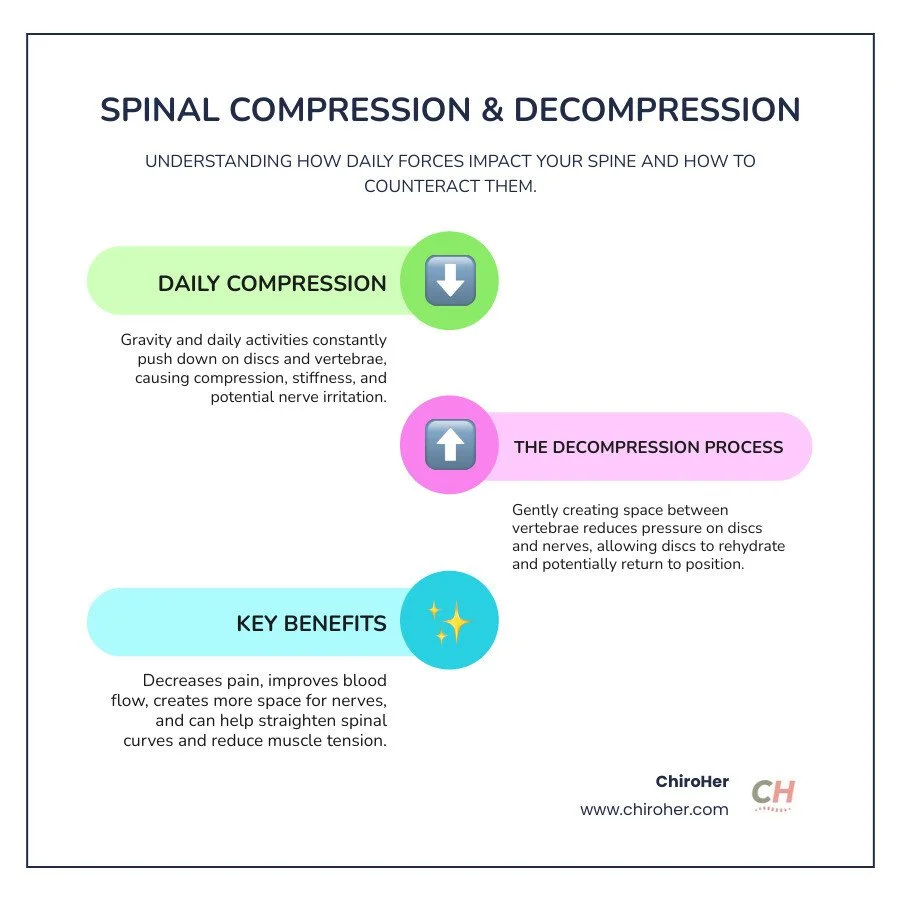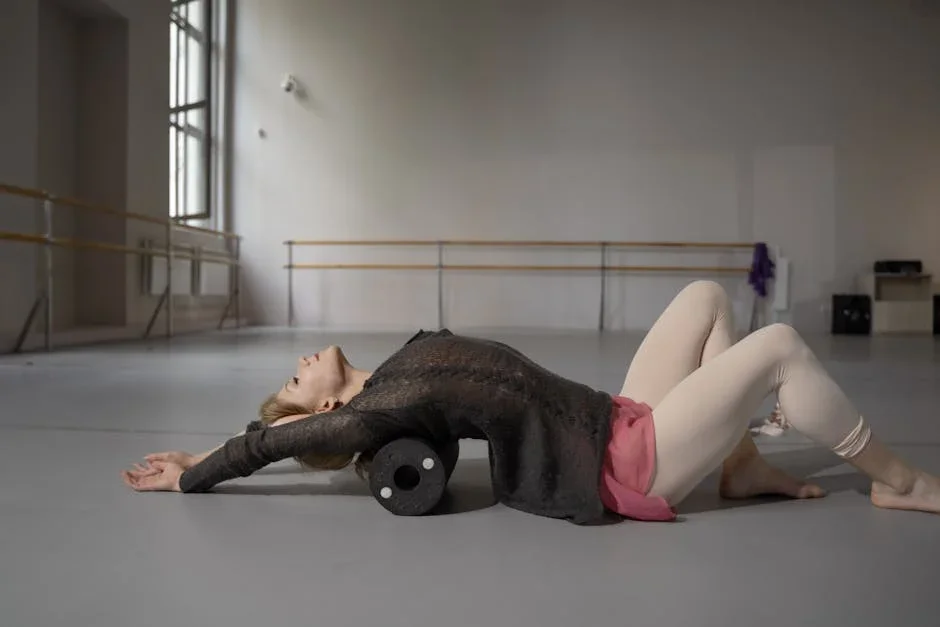Stretch Your Back Anywhere: Alternatives to Inversion Tables
Why Stretch Your Back? Understanding Spinal Decompression
Looking to stretch back without inversion table? Here are effective alternatives you can do anywhere:
Child's Pose - Kneel and reach forward, stretching your spine gently.
Cat-Cow Stretch - Alternate arching and rounding your back on hands and knees.
Bar Hangs - Hang from a pull-up bar or sturdy surface for 20-30 seconds.
Prayer Stretch - Kneel with arms extended forward on the ground.
Standing Kitchen Sink Stretch - Lean forward holding your sink edge.
Foam Rolling - Use a foam roller to release muscle tension.
Most of our waking hours are spent with our spines working against gravity. This constant pressure compresses the vertebrae and discs in your back, which can lead to pain and stiffness. The good news is that you don't need expensive equipment to find relief. Spinal decompression creates space between your vertebrae, reducing pressure on discs and nerves while improving blood flow. Simple stretches can be just as effective as specialized equipment for many people.
Hi! I'm Dr. Michelle Andrews, founder of ChiroHer in Oklahoma City. I've helped hundreds of busy professionals and moms find relief from back pain through personalized chiropractic care and therapeutic exercises. My experience shows that the right combination of simple stretches can provide significant relief when done consistently and safely.
What is Spinal Decompression and How Does it Work?
Think of your spine as a stack of blocks with soft discs in between. Daily activities and gravity compress this stack, squeezing the discs and sometimes pinching nerves. This is spinal compression.
Spinal decompression is the opposite. It's a process that gently creates space between the vertebrae to reverse the effects of gravity. This can take pressure off the discs, allowing them to rehydrate, and create more room for nerves. The result is often reduced pain, especially radiating pain down the leg. Decompression also helps decrease muscle tension and improve blood flow to the small joints in your spine. The goal is a gentle, sustained stretch that lengthens the spine, which can be achieved with simple at-home exercises. More info about natural back pain relief
The Benefits of Relieving Spinal Compression
Regular spinal decompression offers more than temporary pain relief; it promotes a healthier, more resilient back. Here are some key advantages:
Pain Reduction: Creating space between vertebrae takes pressure off pinched nerves, reducing back pain, from dull aches to sharp, radiating discomfort like sciatica.
Improved Posture: Decompression encourages the spine to lengthen and straighten, helping to reverse a hunched posture and improve alignment.
Increased Flexibility: A compressed spine is a stiff spine. Decompression restores natural movement, making it easier to bend and twist without discomfort.
Muscle Relaxation: Decompression can signal tense back muscles to relax, releasing chronic tension and spasms.
Sciatica and Herniated Disc Relief: Decompression can alleviate pressure on the sciatic nerve or a herniated disc, reducing leg pain, numbness, and tingling. It creates a negative pressure that helps the disc material retract. More info about low back sciatic pain
Improved Disc Health: The process promotes fluid and nutrient circulation into the spinal discs, which is important for their health and ability to absorb shock.
Conditions like sciatica, bulging or herniated discs, degenerative disc disease, and spinal stenosis often benefit from these techniques. Addressing the root cause of compression can lead to lasting relief.
How to Stretch Your Back Without an Inversion Table
Patients often ask me about inversion tables, and I tell them that you don't need expensive equipment for effective spinal decompression. Your body has everything it needs to create that healing space between your vertebrae.
I've seen many patients find relief using simple movements they can do anywhere. These techniques use gravity and your own body weight to gently lengthen your spine. The best part is that you can use these stretch back without inversion table methods anytime your back feels tight, with no special setup required.
Simple Bodyweight Exercises to Stretch Back Without Inversion Table
These movements create gentle traction and allow your muscles to relax.
Child's Pose: This is a gentle and effective starting point. Kneel on the floor, spread your knees wide, and lower your hips back toward your heels. Rest your torso between your thighs and extend your arms forward. Hold for 30-60 seconds, breathing deeply. How to do this stretch
Cat-Cow Stretch: This adds movement to mobilize stiff joints. On your hands and knees, exhale as you round your spine toward the ceiling (Cat). Then, inhale as you arch your back, dropping your belly (Cow). Flow through 10-15 cycles.
Bar Hang: This is a powerful decompression technique. Grip a sturdy pull-up bar or countertop edge and let your body hang freely, relaxing your back muscles. If your feet touch the ground, bend your knees. Hold for 20-30 seconds, repeating 3-4 times a day.
Prayer Stretch: Kneel with your glutes on your heels and hinge forward. Extend your arms straight out in front, actively reaching to stretch your mid and upper back.
Standing Kitchen Sink Stretch: Place your hands on a counter, step back with straight arms, and let your torso drop parallel to the floor. This creates a great lengthening sensation and takes only 20-30 seconds.
These exercises encourage your spine to lengthen naturally. More info about therapeutic exercises
Using Simple Tools Like Foam Rollers and Yoga
Simple tools can improve your results by addressing the muscle tension that contributes to spinal compression.
Foam Rolling: This helps release tight muscles around the spine. Lie on your back with a foam roller placed horizontally under your mid-back. Support your head and slowly roll up and down to massage the muscles. Research shows foam rolling can improve circulation and reduce muscle tension. Scientific research on foam rolling
Yoga Poses: Yoga is excellent for spinal health and decompression.
Downward Dog: From hands and knees, lift your hips to form an inverted V. This stretches the entire back of your body and creates space between vertebrae.
Standing Forward Bend: From a standing position, hinge at your hips and fold forward, letting your head hang heavy. This uses gravity to gently stretch your spine.
Yoga improves flexibility, strength, and balance, all of which support better spinal alignment. More info about sciatic nerve stretches
The goal is always gentle, sustained stretching. Never force a movement or push through sharp pain. Consistency is more important than intensity.
Ensuring Your Safety and Knowing When to Get Help
While learning how to stretch back without an inversion table is empowering, it's important to understand your limits and when to seek professional help. Safety should always be the priority, as back pain has many causes and some require a professional diagnosis and treatment plan.
What Research Says About Spinal Decompression
Scientific research on spinal decompression shows mixed results. For example, a 2012 study found that using inversion devices helped 77% of participants avoid surgery, a significant finding. However, a large 2013 Cochrane review concluded that traction alone didn't show dramatic improvements for most people with low back pain.
What does this mean for you? In our practice, we've found that simple exercises often yield similar results to machine-based decompression. The simple movements shared here can be just as effective as expensive equipment. While there's no single solution for everyone, consistent exercise is a valuable part of managing back pain, and our patients' experiences are overwhelmingly positive.
Safety Tips for How to Stretch Back Without Inversion Table
Before starting any new exercises for back pain, please talk with a healthcare professional. It's important for your safety and success.
Certain conditions require medical clearance before attempting these stretches, including:
Pregnancy
Osteoporosis or spinal fractures
Previous spinal fusion surgery or artificial disc placement
High blood pressure
Use of blood-thinning medications
History of spinal infections or tumors
Here are some key safety rules:
Listen to your body: Stretches should feel gentle and relieving, not sharp or painful. Stop immediately if you feel increased discomfort, numbness, or tingling.
Start slowly: Begin with shorter holds and fewer repetitions, gradually increasing as you feel comfortable. Proper form is more important than the depth of the stretch.
Be consistent: A few minutes of daily stretching is more effective than one long, intense session.
Stay hydrated and move regularly: Water is vital for disc health, and changing positions every 20-30 minutes prevents your spine from re-compressing.
If your pain is severe, persistent, or accompanied by weakness or changes in bladder or bowel function, seek immediate medical attention. At ChiroHer, we empower you with at-home techniques but also provide professional care when it's needed. More info about chiropractic care
For our patients in the Oklahoma City area, including Yukon, Edmond, Nichols Hills, Del City, Mustang, and Moore, we are here to find the root cause of your pain and create a plan that works for you. Our patient-focused approach ensures you feel supported.
If you'd like to explore how we can help, I'd love to meet with you. Schedule a consultation with us
This guide is for informational purposes and is not a substitute for already established medical advice from your healthcare provider.





